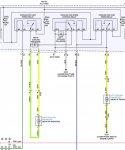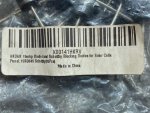I’m working on some wiring for a swap I’m going to be starting on here pretty soon, and I’m going over the factory fan control wiring. The show a couple of diodes, but I’m having trouble figuring out what function they perform in the circuit. I’m guessing maybe it is some sort of damping or something for when it switches from high to low, but I’m really not an expert on this at all. I’ll post a picture of the diagram, and hopefully someone smarter than me on this stuff can tell me what they do.

I need a little electrical help
- Thread starter JoshH
- Start date
You are using an out of date browser. It may not display this or other websites correctly.
You should upgrade or use an alternative browser.
You should upgrade or use an alternative browser.
Thanks for your help. I suspected it was something along those lines. Can you tell enough from the diagram to tell me if these diodes would be ok to use there? I ended up with a bag of them from something, and I figure if they are up to the task, I’ll use them for this too.

Attachments
Those are rated for 45 volts reverse voltage, and you should only see ~14V. During transient surge suppression, they aren't reverse biased. 15 amps forward current continuous with 275 amp surge. Very low forward voltage. Not seeing much info on their RF characteristics, which isn't surprising since they are for solar panels.
I suspect they'll do fine. I'd run them.
I suspect they'll do fine. I'd run them.
Brushed motors can induce several hundred volts or more into the circuit. They will likely be fine for relays but I would use something with much higher voltage rating for brushed motors
That is true about brushed motors, but when used as a flyback diode, it becomes forward biased in the presence of these large back EMF voltages. So reverse voltage breakdown spec only needs to meet ~14v (with some margin). Most important diode spec in this application is peak forward surge current. I would use a minimum of a 1N5408 with 200A surge. 275A from the schottky diodes in the picture is even better than that.
It's trying to pull the voltage negative, not send power back to the truck. That's why the diode allows current to flow from ground to positive, to snub the negative spike that can keep/start an arc in the relay contacts.
The inductance of the motors is like a long water pipe. When things are running, you have positive pressure at the start of the pile. Then you slam the valve shut (relay opens). The pipe will actually create a suction, and on long enough pipes they can collapse. So you run a vacuum breaker allowing air (0 PSI) in to the pipe. Under normal use, it never does anything, but when you slam the valve, it opens and lets in air to prevent the pipe from going to a suction. A diode across the relay is like the vacuum breaker.
Not a perfect analogy, but I find the water comparison for inductance to be a helpful way to mentally model what is happening.
The inductance of the motors is like a long water pipe. When things are running, you have positive pressure at the start of the pile. Then you slam the valve shut (relay opens). The pipe will actually create a suction, and on long enough pipes they can collapse. So you run a vacuum breaker allowing air (0 PSI) in to the pipe. Under normal use, it never does anything, but when you slam the valve, it opens and lets in air to prevent the pipe from going to a suction. A diode across the relay is like the vacuum breaker.
Not a perfect analogy, but I find the water comparison for inductance to be a helpful way to mentally model what is happening.



